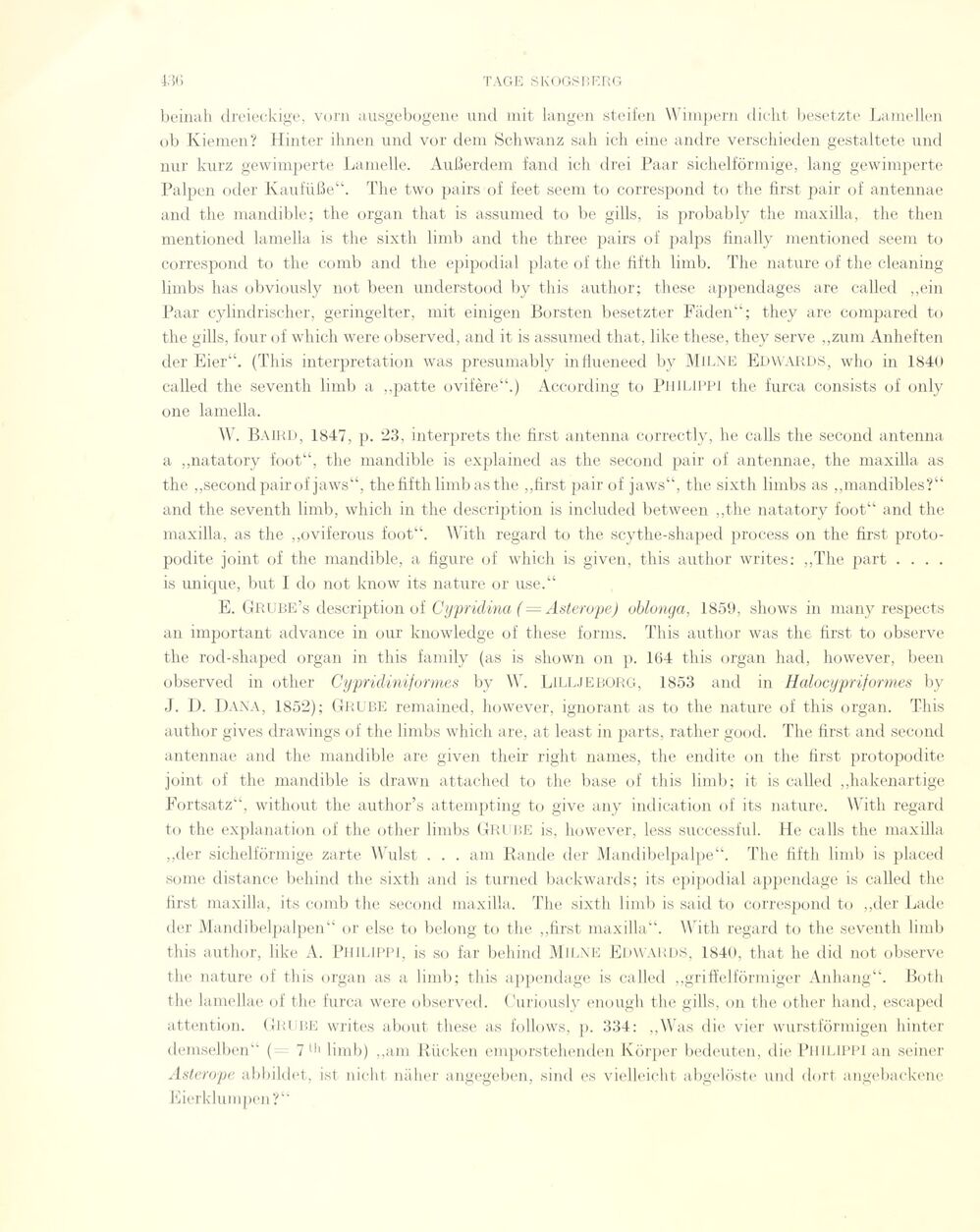
Full resolution (JPEG) - On this page / på denna sida - Sidor ...

<< prev. page << föreg. sida << >> nästa sida >> next page >>
Below is the raw OCR text
from the above scanned image.
Do you see an error? Proofread the page now!
Här nedan syns maskintolkade texten från faksimilbilden ovan.
Ser du något fel? Korrekturläs sidan nu!
This page has never been proofread. / Denna sida har aldrig korrekturlästs.
beinah dreieckige, vorn ausgebogene und mit langen steifen Wimpern dicht besetzte Lamellen
ob Kiemen? Hinter ihnen und vor dem Schwanz sah ich eine andre verschieden gestaltete und
nur kurz gewimperte Lamelle. Außerdem fand ich drei Paar sichelförmige, lang gewimperte
Palpen oder Kaufüße“. The two pairs of feet seem to correspond to the first pair of antennae
and the mandible; the organ that is assumed to be giils, is probably the maxilla, the then
mentioned lamella is the sixth limb and the three pairs of palps finally mentioned seem to
correspond to the comb and the epipodial plate of the fiftli limb. The nature of the cleaning
limbs has obviously not been understood by this author; these appendages are called „ein
Paar cylindrischer, geringelter, mit einigen Borsten besetzter Fäden“; they are compared to
the gills, four of which were observed, and it is assumed that, like these, they serve „zum Anheften
der Eier“. (This interpretation was presumably influeneed by Milne Edwards, who in 1840
called the seventh limb a „patte ovifere“.) According to Philippi the furca consists of only
one lamella.
W. Baird, 1847, p. 23, interprets the first antenna correctly, he calls the second antenna
a „natatory foot“, the mandible is explained as the second pair of antennae, the maxilla as
the „second pair of jaws“, the fifth limb as the „first pair of jaws“, the sixth limbs as „mandibles?“
and the seventh limb, which in the description is included between „the natatory foot“ and the
maxilla, as the „oviferous foot“. With regard to the scythe-shaped process on the first
protopodite joint of the mandible, a figure of which is given, this author writes: „The part . . . .
is unique, but I do not know its nature or use.“
E. Grube’s description of Cypridina (= Asterope) oblonga, 1859, shows in many respects
an important advance in our knowledge of these forms. This author was the first to observe
the rod-shaped organ in this family (as is shown on p. 164 this organ had, however, been
observed in other Cypridiniformes by W. Lilljeborg, 1853 and in Halocypriformes by
J. D. DANA, 1852); Grube remained, however, ignorant as to the nature of this organ. This
author gives drawings of the limbs which are, at least in parts, rather good. The first and second
antennae and the mandible are given their right naines, the endite on the first protopodite
joint of the mandible is drawn attached to the base of this limb; it is called „hakenartige
Fortsatz“, without the author’s attempting to give any indication of its nature. With regard
to the explana tion of the other limbs GRUBE is, however, less successful. He calls the maxilla
„der sichelförmige zarte Wulst . . . am Rande der Mandibelpalpe“. The fifth limb is placed
so me distance behind the sixth and is turned backwards; its epipodial appendage is called the
first maxilla, its comb the second maxilla. The sixth limb is said to correspond to „der Lade
der Mandibelpalpen“ or eise to belong to the „first maxilla“. With regard to the seventh limb
this author, like A. Philippi, is so far behind Milne Edwards, 1840, that he did not observe
the nature of this organ as a limb; this appendage is called „griffelförmiger Anhang“. Both
the lamellae of the furca were observed. Curiously enough the gills, on the other hand, escaped
attention. Grube writes about these as follows, p. 334: „Was die vier wurstförmigen hinter
demselben“ ( — 711’ limb) „am Rücken emporstehenden Körper bedeuten, die Philippi an seiner
Asterope abbildet, ist nicht näher angegeben, sind es vielleicht abgelöste und dort angebackene
Eierklumpen?“
<< prev. page << föreg. sida << >> nästa sida >> next page >>